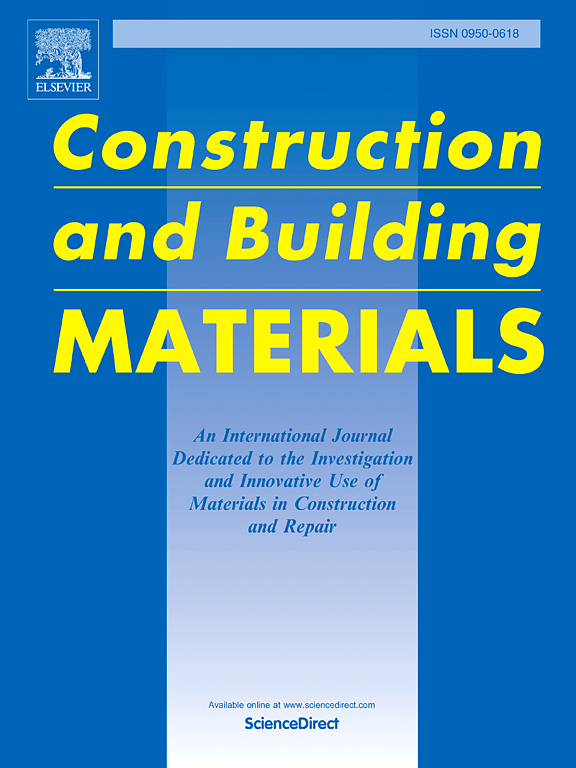无机共晶salt@SiO2相变微胶囊的制备及其对石膏基复合材料力学和热性能的影响
IF 7.4
1区 工程技术
Q1 CONSTRUCTION & BUILDING TECHNOLOGY
引用次数: 0
摘要
相变材料通过相变期间的热吸收/释放,为提高建筑能源效率提供了潜力。本研究以改性共晶水合盐为核心,采用Pickering乳化法制备双组分二氧化硅/纳米二氧化硅壳,制备了新型无机水合salt@SiO2相变微胶囊。将这些微胶囊掺入石膏中形成功能复合材料。综合研究了改性共晶水合盐和微胶囊的热性能,以及复合材料的力学性能和热管理能力。优化后的微胶囊表面粗糙,平均尺寸为6.3 μm,相变温度为21.31℃,焓为286.8 J/g。值得注意的是,经过120次加热-冷却循环后,焓损失被限制在0.4 %。复合性能:在石膏复合材料中,7天抗压和抗弯强度峰值为10.8 MPa和5.3 MPa(2.0 wt%微胶囊),下降至6.6 MPa和3.5 MPa(4.0 wt%微胶囊)。红外热成像证实了有效的热缓冲:加入4.0 wt%的微胶囊在480 s加热后,表面温度比对照样品降低了4°C。同时,导热系数降低了32.8% %(以4.0 wt%含量测量),进一步增强了建筑热调节的潜力。通过昼夜相变循环延迟热量传递,它们直接减少了炎热气候下的冷负荷,使空调建筑每年节省大量能源,并推进可持续建筑。本文章由计算机程序翻译,如有差异,请以英文原文为准。
Fabrication of inorganic eutectic salt@SiO2 phase change microcapsules and their influence on mechanical and thermal properties of gypsum-based composites
Phase change materials offer potential for improving building energy efficiency through heat absorption/release during phase transition. This study develops novel inorganic hydrated salt@SiO2 phase change microcapsules using modified eutectic hydrated salt as the core and a dual-component silica/nanosilica shell via the Pickering emulsion method. These microcapsules were incorporated into gypsum for forming functional composites. Comprehensive investigations were conducted to evaluate the thermal properties of the modified eutectic hydrated salts and the microcapsules, alongside the mechanical properties and thermal management capabilities of the composites. Optimized microcapsule properties: The optimized microcapsules exhibited a rough surface, an average size of 6.3 μm, a phase-change temperature of 21.31°C, and an enthalpy of 286.8 J/g. Remarkably, the enthalpy loss was limited to 0.4 % after 120 heating-cooling cycles. Composite performance: In the gypsum composites, 7-day compressive and flexural strengths peaked at 10.8 MPa and 5.3 MPa (2.0 wt% microcapsules), declining to 6.6 MPa and 3.5 MPa at 4.0 wt%. Infrared thermography confirmed effective thermal buffering: incorporating 4.0 wt% microcapsules reduced surface temperature by 4°C versus the control specimen after 480 s heating. Concurrently, thermal conductivity decreased by 32.8 % (measured at 4.0 wt% content), further enhancing potential for building thermal regulation. By delaying heat transfer through diurnal phase-change cycles, they directly reduce cooling loads in hot climates, enabling significant annual energy savings in air-conditioned buildings and advancing sustainable construction.
求助全文
通过发布文献求助,成功后即可免费获取论文全文。
去求助
来源期刊

Construction and Building Materials
工程技术-材料科学:综合
CiteScore
13.80
自引率
21.60%
发文量
3632
审稿时长
82 days
期刊介绍:
Construction and Building Materials offers an international platform for sharing innovative and original research and development in the realm of construction and building materials, along with their practical applications in new projects and repair practices. The journal publishes a diverse array of pioneering research and application papers, detailing laboratory investigations and, to a limited extent, numerical analyses or reports on full-scale projects. Multi-part papers are discouraged.
Additionally, Construction and Building Materials features comprehensive case studies and insightful review articles that contribute to new insights in the field. Our focus is on papers related to construction materials, excluding those on structural engineering, geotechnics, and unbound highway layers. Covered materials and technologies encompass cement, concrete reinforcement, bricks and mortars, additives, corrosion technology, ceramics, timber, steel, polymers, glass fibers, recycled materials, bamboo, rammed earth, non-conventional building materials, bituminous materials, and applications in railway materials.
 求助内容:
求助内容: 应助结果提醒方式:
应助结果提醒方式:


